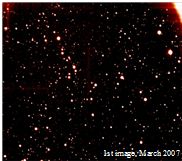SPACE AND GROUND INSTRUMENTATION
LOLS participated in several astrophysical instruments and instrument pipelines for both space and ground. See them all!
SPACE INSTRUMENTATION
FPASS (2006) – This Focal Plane Assembly Static Simulator was developed for EADS Astrium after GAIA prime contractor was assigned. This simulator takes into account all the details of the two telescopes sharing a common focal plane, and generates images and samples. All the specificities of the optics, telescopes, CCDs, noises, attitude instabilities and universe models are taken into account.
FCUL is also a member of the GAIA DPAC (Data Processing Analysis Consortium) (2007-2010) who is developing the ground segment of GAIA from the data processing perspective. The Portuguese part also includes the Universities of Lisbon, Coimbra and Porto, UNINOVA and Critical Software. FCUL / LOLS participated in the development of instrument models used by GAIA simulators, in particular the models of the dispersive instruments.
Finally, FCUL / LOLS cooperated with Lusospace in the development and calibration of an optical head to test Gaia focal plane (a large mosaic of large format 106 CCD) in thermal vacuum. FCUL focused on radiometric issues to ensure that the light beams generated by the optical head generated the right radiance in the focal plane.
FCUL capitalized on its background in optics to design optical systems for ESO (CAMCAO - an infrared camera for the Overwhelming Large Telescope, OWL – VSI – a spectrograph imager for the VLT - and HRUSS – a ultra-stable spectrograph, also for VLT), and to develop diffractive optical variable devices for the security market to integrate several optical systems into integrated platforms for the industry.
GROUND INSTRUMENTATION
CAMCAO (2002-2004) - The ESO Multi-conjugate Adaptive optics Demonstrator (MAD) is an essential component to demonstrate on sky Multi-Conjugate Adaptive Optics techniques (MCAO), both the OWL 100 m telescope concept and for the ESO VLT 2nd generation instrumentation. MAD is intended to be a MCAO prototype to be tested at VLT Visitor Focus. It is conceived as a fast track project by re-using as much as possible key components developed in the scope of existing VLT adaptive optics systems.

CAMCAO is the infrared camera of MAD contracted by ESO to a Portuguese team (FCUL(SIM and LOLS) and LIP) in June 2002. LOLS performed the optical design of the camera and specified all optical components. Vacuum and cryogenic tests, led by SIM, were successful in February 2005, thus validating the optical design. The system is operational and delivering scientific data.
VSI (2007-2009) - This is the Phase A study of the Very Large Telescope Spectro-Imager, in which FCUL and FEUP integrated a wider European team to design and build the interferometric spectral imager. LOLS was involved in the beam injection module, alignment and spectral calibration tools and procedures.
ESPRESSO (2009-2015) - FCUL is part of the High Resolution, Ultra Stable Spectrograph consortium, led by the University of Geneve, to combine incoherently the four VLT telescopes to feed a high resolution, ultra stable spectrograph. This instrument is intended as an additional second-generation instrument for the VLT and will look for planets in non-solar systems. FCUL/LOLS is in charge of the optical design and manufacture of the optical relay optics to bring the light into the combined Coudé Laboratory.
